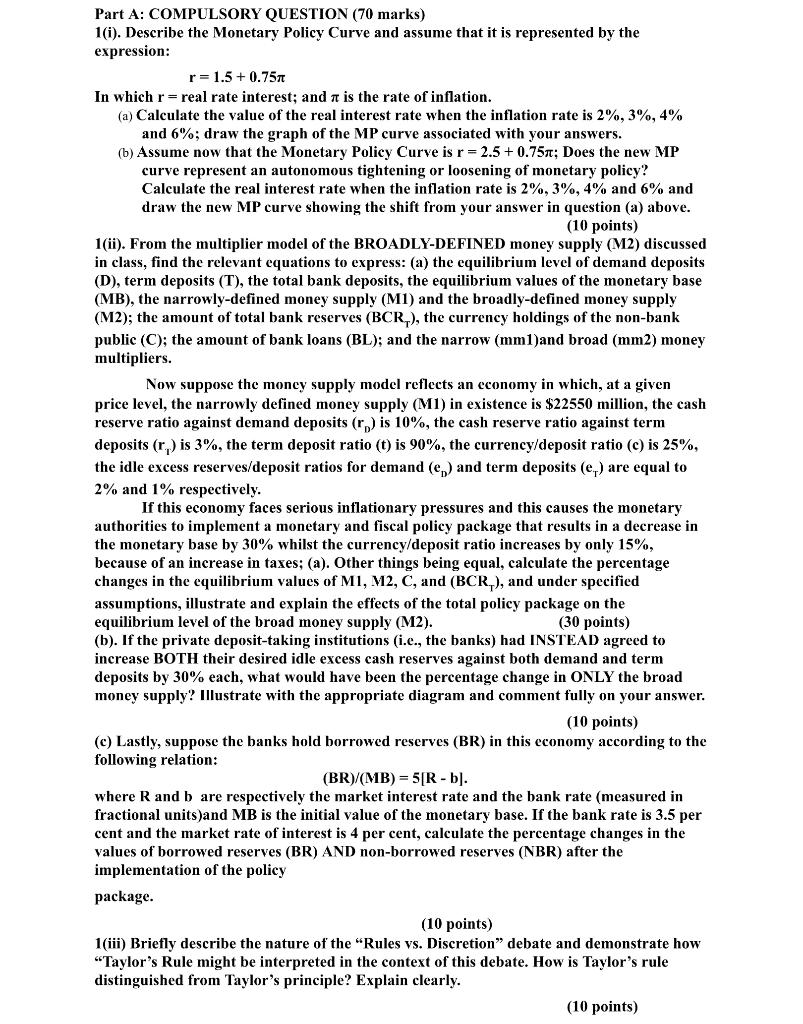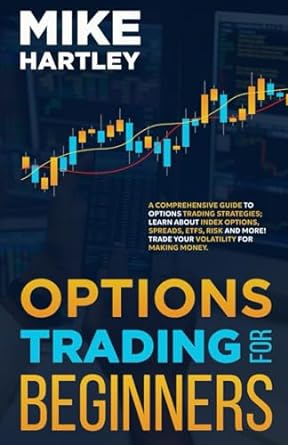
Part A: COMPULSORY QUESTION (70 marks) 1(i). Describe the Monetary Policy Curve and assume that it is represented by the expression: r=1.5 + 0.7571 In which r=real rate interest; and is the rate of inflation. (a) Calculate the value of the real interest rate when the inflation rate is 2%, 3%, 4% and 6%; draw the graph of the MP curve associated with your answers. (6) Assume now that the Monetary Policy Curve is r = 2.5 +0.751; Does the new MP curve represent an autonomous tightening or loosening of monetary policy? Calculate the real interest rate when the inflation rate is 2%, 3%, 4% and 6% and draw the new MP curve showing the shift from your answer in question (a) above. (10 points) 1(ii). From the multiplier model of the BROADLY-DEFINED money supply (M2) discussed in class, find the relevant equations to express: (a) the equilibrium level of demand deposits (D), term deposits (T), the total bank deposits, the equilibrium values of the monetary base (MB), the narrowly-defined money supply (MI) and the broadly-defined money supply (M2); the amount of total bank reserves (BCR,), the currency holdings of the non-bank public (C); the amount of bank loans (BL); and the narrow (mml)and broad (mm2) money multipliers. Now suppose the money supply model reflects an economy in which, at a given price level, the narrowly defined money supply (M1) in existence is $22550 million, the cash reserve ratio against demand deposits (ro) is 10%, the cash reserve ratio against term deposits (r.) is 3%, the term deposit ratio (t) is 90%, the currency/deposit ratio (e) is 25%, the idle excess reserves/deposit ratios for demand (en) and term deposits (e) are equal to 2% and 1% respectively. If this economy faces serious inflationary pressures and this causes the monetary authorities to implement a monetary and fiscal policy package that results in a decrease in the monetary base by 30% whilst the currency/deposit ratio increases by only 15%, because of an increase in taxes; (a). Other things being equal, calculate the percentage changes in the equilibrium values of MI, M2, C, and (BCR..), and under specified assumptions, illustrate and explain the effects of the total policy package on the equilibrium level of the broad money supply (M2). (30 points) (b). If the private deposit-taking institutions (i.e., the banks) had INSTEAD agreed to increase BOTH their desired idle excess cash reserves against both demand and term deposits by 30% each, what would have been the percentage change in ONLY the broad money supply? Illustrate with the appropriate diagram and comment fully on your answer. (10 points) (c) Lastly, suppose the banks hold borrowed reserves (BR) in this economy according to the following relation: (BR)/(MB) = 5[R - b). where R and b are respectively the market interest rate and the bank rate (measured in fractional units)and MB is the initial value of the monetary base. If the bank rate is 3.5 per cent and the market rate of interest is 4 per cent, calculate the percentage changes in the values of borrowed reserves (BR) AND non-borrowed reserves (NBR) after the implementation of the policy package. (10 points) 1(iii) Briefly describe the nature of the "Rules vs. Discretion debate and demonstrate how "Taylor's Rule might be interpreted in the context of this debate. How is Taylor's rule distinguished from Taylor's principle? Explain clearly. (10 points) Part A: COMPULSORY QUESTION (70 marks) 1(i). Describe the Monetary Policy Curve and assume that it is represented by the expression: r=1.5 + 0.7571 In which r=real rate interest; and is the rate of inflation. (a) Calculate the value of the real interest rate when the inflation rate is 2%, 3%, 4% and 6%; draw the graph of the MP curve associated with your answers. (6) Assume now that the Monetary Policy Curve is r = 2.5 +0.751; Does the new MP curve represent an autonomous tightening or loosening of monetary policy? Calculate the real interest rate when the inflation rate is 2%, 3%, 4% and 6% and draw the new MP curve showing the shift from your answer in question (a) above. (10 points) 1(ii). From the multiplier model of the BROADLY-DEFINED money supply (M2) discussed in class, find the relevant equations to express: (a) the equilibrium level of demand deposits (D), term deposits (T), the total bank deposits, the equilibrium values of the monetary base (MB), the narrowly-defined money supply (MI) and the broadly-defined money supply (M2); the amount of total bank reserves (BCR,), the currency holdings of the non-bank public (C); the amount of bank loans (BL); and the narrow (mml)and broad (mm2) money multipliers. Now suppose the money supply model reflects an economy in which, at a given price level, the narrowly defined money supply (M1) in existence is $22550 million, the cash reserve ratio against demand deposits (ro) is 10%, the cash reserve ratio against term deposits (r.) is 3%, the term deposit ratio (t) is 90%, the currency/deposit ratio (e) is 25%, the idle excess reserves/deposit ratios for demand (en) and term deposits (e) are equal to 2% and 1% respectively. If this economy faces serious inflationary pressures and this causes the monetary authorities to implement a monetary and fiscal policy package that results in a decrease in the monetary base by 30% whilst the currency/deposit ratio increases by only 15%, because of an increase in taxes; (a). Other things being equal, calculate the percentage changes in the equilibrium values of MI, M2, C, and (BCR..), and under specified assumptions, illustrate and explain the effects of the total policy package on the equilibrium level of the broad money supply (M2). (30 points) (b). If the private deposit-taking institutions (i.e., the banks) had INSTEAD agreed to increase BOTH their desired idle excess cash reserves against both demand and term deposits by 30% each, what would have been the percentage change in ONLY the broad money supply? Illustrate with the appropriate diagram and comment fully on your answer. (10 points) (c) Lastly, suppose the banks hold borrowed reserves (BR) in this economy according to the following relation: (BR)/(MB) = 5[R - b). where R and b are respectively the market interest rate and the bank rate (measured in fractional units)and MB is the initial value of the monetary base. If the bank rate is 3.5 per cent and the market rate of interest is 4 per cent, calculate the percentage changes in the values of borrowed reserves (BR) AND non-borrowed reserves (NBR) after the implementation of the policy package. (10 points) 1(iii) Briefly describe the nature of the "Rules vs. Discretion debate and demonstrate how "Taylor's Rule might be interpreted in the context of this debate. How is Taylor's rule distinguished from Taylor's principle? Explain clearly. (10 points)







